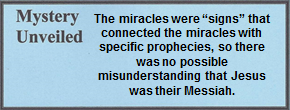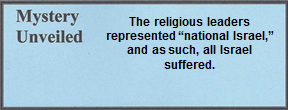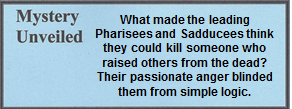12.03.12 Jn. 11:45-53 Jerusalem
SANHEDRIN PLOTS TO KILL JESUS
45 Therefore, many of the Jews who came to Mary and saw what He did believed in Him. 46 But some of them went to the Pharisees and told them what Jesus had done.
47 So the chief priests and the Pharisees convened the Sanhedrin and said, “What are we going to do since this man does many signs? 48 If we let Him continue in this way, everyone will believe in Him! Then the Romans will come and remove both our place and our nation.”
49 One of them, Caiaphas, who was high priest that year, said to them, “You know nothing at all! 50 You’re not considering that it is to your advantage that one man should die for the people rather than the whole nation perish.” 51 He did not say this on his own, but being high priest that year he prophesied that Jesus was going to die for the nation, 52 and not for the nation only, but also to unite the scattered children of God. 53 So from that day on they plotted to kill Him.
“What are we going to do since this man does many signs?” What an incredible confession – a confession that they recognized that Jesus had performed many signs proving beyond any shadow of doubt that He was the expected messiah. He had not only performed the three messianic miracles, but by raising the dead to life, He went beyond those three incredible miracles.[1] But rather than accepting Him for who He was, they were more concerned about losing “both our place and our nation.” Interestingly, in the year A.D. 70, they lost everything they feared they would lose, and they didn’t have Jesus either. It wasn’t just that Jesus performed miracles, but these miracles were “signs.” The term connected the miraculous events with specific prophecies of messianic identity. There was absolutely no possibility of ignorance – but a full knowledge rejection of Jesus the Messiah.

The “signs” of miracles were so many, that the modern reader forgets that there were many other signs as well – prophetic signs that He fulfilled.
“Caiaphas, who was high priest that year.” Caiaphas was the chief instigator, using whatever dictatorial methods possible, to have Jesus executed. As high priest, he was to represent the people to their God. Instead, he was an impatient, insulting, overbearing and Hellenistic tyrant similar to Herod the Great. Both Caiaphas and Herod the Great were the ultimate in greed personified. No one dared to speak against either one without first considering the consequences.
Critics have argued that this phrase reflects an error in John’s account, because according to the Law of Moses, the high priest held his position for life. They are correct concerning the Law of Moses, however, the first century high priest was a position filled by the local Roman governor. Furthermore, neither the Sadducees nor the Romans had any regard for the Laws of Moses. Yet it is an interesting irony of history that in that year, Caiaphas would be the instrument in the sacrifice of Him who would take away the sin of the world.
12.03.12.Q1 Did the high priest have a rope tied around his ankle when he entered the Holy of Holies?
A traditional myth says that whenever the high priest went into the Holy of Holies, he had a rope tied around his ankle. This was because if there was any sin found in him, God would strike him dead. The end of the rope was available for others to pull his body out without entering the sacred area. According to scholars at the Temple Institute this writer has interviewed, this teaching is false.[2] Furthermore, there is no evidence of this practice in any rabbinic writings that carefully describe the activities in the temple. Were that myth to have been true, then one must question why God did not kill several high priests, especially Caiaphas who one of the most evil of all high priests?
“You know nothing at all!” This is hardly the kind of speech one would expect from a priest, and especially a high priest. However, Caiaphas was hardly a person with any God-like characteristics, but he was typical of all the Sadducees. Josephus made this comment about them.
The behavior of the Sadducees to one another is rather crude, and their intercourse (conversation) with their equals is rough, as it is with strangers.
Josephus, Wars 2.8.14 (166b)[3]
Amazingly, Mark refers to the Sadducees once by name and Luke refers to them five times, but only in his book of Acts. John never calls them by name at all. Yet they were the primary instigators that led to the crucifixion. The leading Pharisees clearly challenged Jesus numerous times and even planned His death, but eventually stepped aside and let the Sadducees do their dirty work.
“You’re not considering that it is to your advantage that one man should die for the people rather than the whole nation perish.” Is it not amazing that Caiaphas spoke these words, since they became profoundly prophetic? This was the formal declaration to have Jesus killed. Just as the pagan prophet Balaam gave a true prophecy (Num. 24:17), so did the Hellenistic Caiaphas. National Israel would now be guilty of His death. To Caiaphas the death of Jesus would solve a political-religious problem while to God the death would solve the sin problem of all humanity. The irony is that while the Romans repeatedly crucified messianic pretenders,[4] when the real messiah was before them, they repeatedly found Him innocent. Only the religious leaders wanted Him crucified. The most common people and many in the Sanhedrin knew the life and reputation of Jesus was above reproach. As will be shown, it was the Sadducees and not the leading Pharisees, who eventually condemned Jesus to death and turned Him over to the Romans for execution.

To be a member of the distinguished Sanhedrin, a man had to be a minimum age of thirty, although most members were much older in this life-long career. Since Jesus was only in His mid-thirties by now, His words were all the more painful. He cut through their rhetoric and exposed their impure motives in public. It was extremely embarrassing for older men when a young man like Him repeatedly won arguments in a culture where the words of a Sanhedrin member were considered almost sacred. Obviously, there was an overemphasis on the value of their opinions. But in Jewish thinking, since Jesus raised Lazarus from the dead, could He also successfully overthrow the Romans and annihilate the existing temple? They concluded it would be much better to kill Jesus and remain under Roman rule.

“To unite the scattered children of God.” John prophesied that the Jews would one day be restored. This pertained not only to the Jews who lived in the Promised Land, but also to those who were scattered abroad in many nations. Since he did not place any limitations on the restoration of unity, it must be understood to mean both physical (return to Israel) and spiritual (acceptance of Jesus [Yeshua]) as Lord and Savior.[5] This interpretation, however, is a matter of debate. The early church made use of these prophetic words in a book titled The Teaching of the Twelve Apostles, also known as the Didache. When the bread is broken,
Even as this bread is scattered across the mountains, and was brought into one, so let the Church be brought together from the ends of the earth into the kingdom.
Didache 9:4[6]
[1]. The three messianic miracles are 1). Healing a Jewish leper. 2). The casting out of demons from someone who could not speak. 3). Healing a person who was born blind. See 06.03.08.Q2 “What were the three “messianic miracles” that first century Jews believed the messiah would perform?” See also Fischer, The Gospels in Their Jewish Context. (Lecture on CD/MP3). Week 10, Session 2.
[2]. Interviews in October, 1998. See https://www.templeinstitute.org/ for more information on the Institute that has re-created the vessels and garments for the new temple.
[3]. Clarification in parenthesis mine.
[4]. A partial listing of an estimated 60 messianic pretenders is found in Appendix 25 “False Prophets, Rebels, Significant Events, And Rebellions That Impacted The First Century Jewish World.”
[5]. Mills and Michael, Messiah and His Hebrew Alphabet. 7.
[6]. The Didache is a book on church order that was written within a century of the life of Jesus. For more information, see 02.02.08.